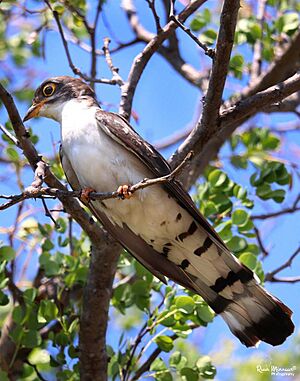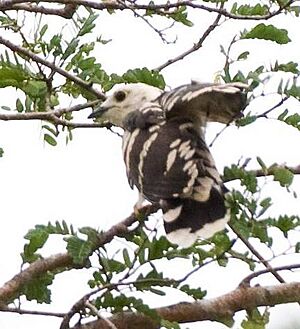Thick-billed cuckoo facts for kids
Quick facts for kids Thick-billed cuckoo |
|
|---|---|
 |
|
 |
|
| An adult and juvenile bird in South Africa and Tanzania respectively | |
| Conservation status | |
| Scientific classification | |
| Genus: |
Pachycoccyx
|
| Species: |
audeberti
|
The thick-billed cuckoo (Pachycoccyx audeberti) is a special type of cuckoo bird. It belongs to the cuckoo family, called Cuculidae. This bird is the only species in its group, which is named Pachycoccyx.
You can easily spot the thick-billed cuckoo because of its very thick beak. This beak looks a bit like a hawk's beak. This feature helps it stand out from other cuckoos that lay their eggs in other birds' nests.
Contents
About the Thick-Billed Cuckoo
The thick-billed cuckoo is a unique bird. It is known for its distinctive beak and its interesting way of raising its young. Scientists have studied this bird to learn more about its family tree and how it lives.
Where Do They Live?
These cuckoos live in warm, wet forests and woodlands. You can find them across Africa, from Guinea in the northwest to Mozambique in the southeast. However, they are not found in all parts of the Congo Basin.
Long ago, they also lived in the rainforests of northeastern Madagascar. But no one has seen them there since 1922. In the southern parts of their home, some thick-billed cuckoos move to East Africa during the dry season.
What Do They Eat?
Like many cuckoos, the thick-billed cuckoo enjoys eating caterpillars, especially the hairy ones. But they also really like to munch on grasshoppers and praying mantises. These insects are a big part of their diet.
How Do They Reproduce?
The thick-billed cuckoo is a special kind of bird called a brood parasite. This means it does not build its own nest or raise its own chicks. Instead, the female cuckoo lays her eggs in the nests of other birds.
Cuckoo's Host Families
The thick-billed cuckoo mostly lays its eggs in the nests of birds called helmetshrikes. In eastern Africa, they use the nests of the red-billed helmetshrike and the chestnut-fronted helmetshrike. In West Africa, they choose the chestnut-bellied helmetshrike. This means the cuckoo's breeding areas are limited to where these helmetshrikes live.
Impact on Host Nests
Studies have shown that the thick-billed cuckoo can greatly affect the helmetshrikes. For example, in one group of red-billed helmetshrikes, the cuckoos stopped them from raising any of their own chicks for five years! About 35% to 55% of helmetshrike nests were taken over by cuckoo eggs.
It is thought that the thick-billed cuckoos that used to live in Madagascar probably laid their eggs in the nests of vangas. Vangas are birds related to helmetshrikes. The black cuckoo, a similar-sized bird, also lays its eggs in other birds' nests, but it chooses bush shrikes.


